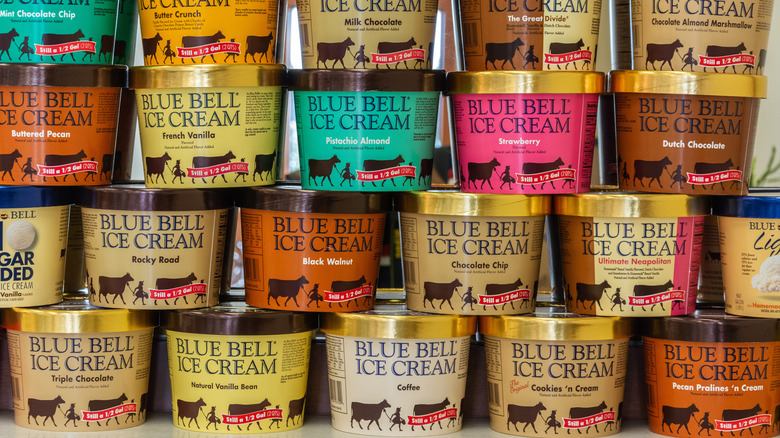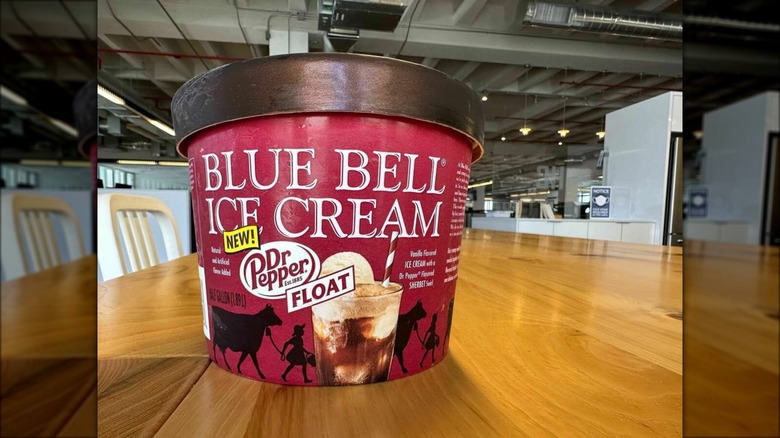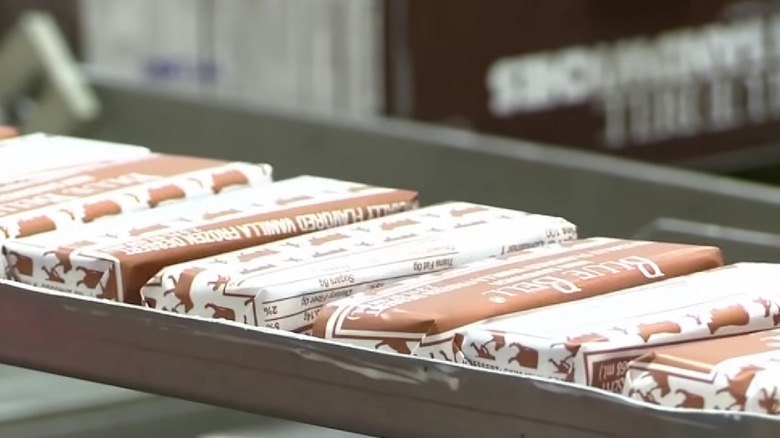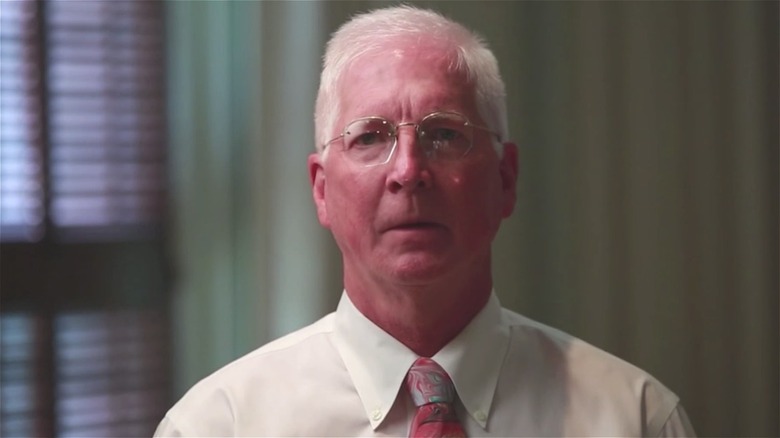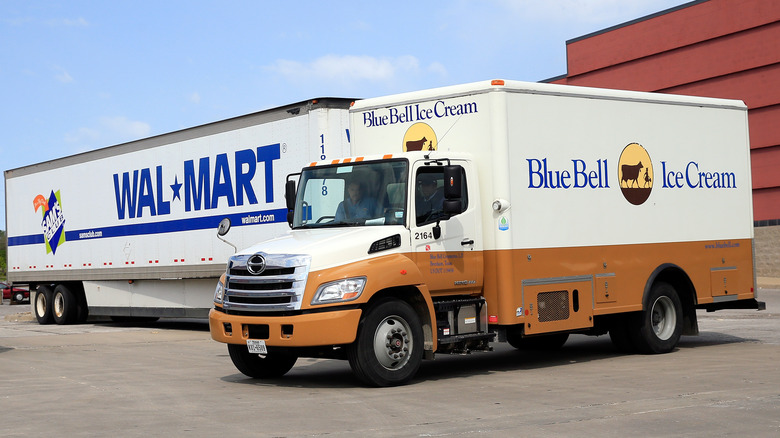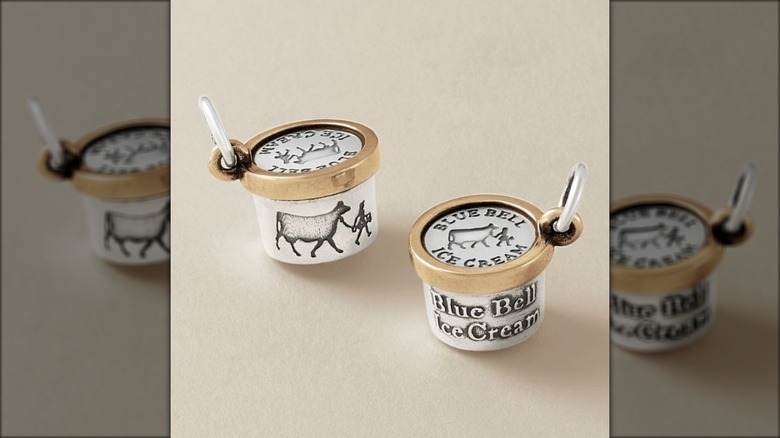Blue Bell: 14 Facts About The Popular Ice Cream Brand
Blue Bell Creameries is an ice cream brand that got its start in Texas. In the '80s, the brand expanded outside of the state and quickly became adored all over the South thanks to its association with the area, nostalgic marketing, and long history.
Of course, flavor also plays a huge role. Blue Bell Ice Cream is known for its strong taste and decadent, creamy texture. For this reason, according to the Blue Bell Ice Cream website, it carries the unofficial slogan: "The best ice cream in the country."
While Blue Bell can appear like one big success story, there are several unsavory facts about the company. These include an infamous Listeria outbreak and subsequent wire fraud and conspiracy accusations that were leveled against former CEO Paul Kruse.
Add to this a few failed flavors, and it's clear that Blue Bell Ice Cream has had to fight for its spot at the top of the ice cream industry. What follows are 14 facts that'll help you decide if the brand deserves this position and whether it can really claim to be the best ice cream in the country.
1. The company was founded in 1907
Blue Bell Creameries was founded in 1907 as the Brenham Creamery Company by a group of local businessmen. Initially, the role of the company was to produce sour cream butter from surplus cream produced in the area. As Ed Kruse, a former chairman and chief executive officer of Blue Bell, highlighted to The Medallion, this cream was not hard to come by: "In Brenham, most people had a couple of cows, and they would have more milk and cream than they could use."
H. C. Hodde, one of the company's early managers, pushed for the brand to make use of excess sweet cream as well as sour. In 1911, the company acted on his advice, producing two gallons of ice cream via a labor-intensive hand crank method. Thanks to a positive response to the product, the company invested in specialist equipment to produce 6,000 gallons of ice cream the following year.
E. F. Kruse was hired as manager of the Brenham Creamery Company in 1919. He was the one to rename the company Blue Bell Creameries in 1930 and was succeeded upon his death in 1951 by his two children, Ed and Howard Kruse.
Under their leadership, Blue Bell Creameries ceased butter production to focus on ice cream. Further generations of the Kruse family have also played major roles in the business development, including the former CEO and president, Paul Kruse and the current chairman of the board, Jim Kruse.
2. Blue Bell ice cream is available in 23 states
Between 1911 and 1989, Blue Bell Creamery ice cream could only be purchased within Texas. The reluctance to distribute the ice cream further afield was largely due to concerns about quality. Blue Bell has been adamant that all processes — even delivery – must be controlled centrally to ensure standards are maintained.
This was highlighted by Ed Kruse in a 2006 interview with The New York Times: "We make it all, we deliver it all in our own trucks and we maintain all the stock in retailers' freezers. Ice cream does not do well if it isn't handled carefully. The texture is ruined by any significant variation in temperature."
Today, Blue Bell ice cream is available in 23 states. Improved technology has allowed Blue Bell to expand without employing the use of franchisees or losing central control. To increase its reach, Blue Bell Creameries built new facilities and now boasts production facilities in Texas, Oklahoma, and Alabama, as well as numerous transfer stations and distribution facilities.
Despite this expansion, Blue Bell is still available in fewer states than its competitors. Nonetheless, the company still puts up impressive sales; Blue Bell had the third-largest sales total of any ice cream brand in the United States in 2022. According to Statista, these sales exceeded $650 million.
3. Blue Bell has made various claims about Cookies 'n Cream
Blue Bell Creameries produces a variety of ice cream flavors, including Cookies 'n Cream. This flavor is not Blue Bell's most popular. It is, however, the most contentious as, at different periods throughout the company's history, Blue Bell has made various claims about the flavor. These claims concern whether Blue Bell Creameries was the first to invent the now ubiquitous ice cream flavor.
In a 2005 press release, Blue Bell Creameries claimed that, upon releasing Cookies 'n Cream in 1980, it was the first to produce the flavor on an industrial scale. This comment was reinforced by a 2006 New York Times article that labeled Blue Bell Creameries as a pioneer of the flavor but not the inventor.
However, on Blue Bell Creameries' current website, the company makes the bold claim that: "We were first to create this innovative flavor." To make matters even more confusing, various other businesses and institutions also claim to have invented the flavor. These include South Dakota State University, Dreyer's, and Herrell's.
4. People can visit the original creamery in Brenham
The original Blue Bell location in Brenham is still open and operating today. Aside from being a functioning production facility, the creamery has become a bonafide tourist attraction. Visitors can take a self-guided tour around the visitor's center, learning about the history of Blue Bell Creameries. There is also an on-site ice cream parlor and a store that stocks various forms of Blue Bell Creameries merchandise.
One visitor described their experience at the Brenham production facility on TripAdvisor as follows: "If you are anywhere near Brenham you must stop at Bluebell. Sadly their fabulous tours are no longer running, those were amazing, but you can still get a dose of history and a $1 scoop of delicious Blue Bell, some flavors are only available at parlors! A Texas must see!"
Those who aren't passing through Texas anytime soon can still get the Blue Bell experience. One of Blue Bell's other production facilities, located in Sylacauga, Alabama, is also open to the public. As with the location in Brenham, the Sylacauga facility boasts an observation deck where visitors can watch the ice cream being made.
5. The company releases up to six new flavors a year
Blue Bell Creameries keeps fans engaged by releasing between three to six new ice cream flavors every year. These flavors complement several established flavors that rotate throughout the year. Some classics, such as the extremely popular Homemade Vanilla, are available all year round.
While only three to six new flavors are released, hundreds of potential flavor combinations are appraised. Many of these are submitted by Blue Bell fans from around the country — employees can also suggest flavors. Only 25 flavors are actually trialed each year, with 12 being taken into further development.
Christy Moran, research and development manager at Blue Bell, described this process in an interview with Houston Chronicle. "Creating an ice cream flavor is a lot of science but it can also be a lot of art," she said. "It takes many different iterations to come up with the final product."
Although the company has a rigorous testing process, sometimes poor-performing ice creams still make it to market. This is not the developer's fault; some flavors don't sell well, as was the case for Blue Bell's Peanut Butter and Jelly ice cream. Others seemed doomed from the get-go, as exemplified by Dill Pickle 'n Cream, a green ice cream flecked with pieces of pickle chips. Unsurprisingly, this flavor did not become a fan favorite.
6. Blue Bell also produces ice cream style snacks
Blue Bell Creameries has built its reputation on the quality of its half-gallon ice cream products. However, the company does produce a range of other frozen treats, most notably ice cream-style snacks. Among the most popular of these is the company's Mooo Bar, a vanilla-flavored frozen bar that's coated with chocolate. First released in 1985, the product was only reintroduced to the market in 2018.
Another well-liked Blue Bell snack is the Ice Cream Sandwich. Again, this features the brand's famous vanilla ice cream, but this time, it is sandwiched between chocolate wafers. Interestingly, the company eschews ice cream altogether for its Banana Pops. All of these products contain artificial flavorings.
Blue Bell also sells its ice cream in snack-sized cups. These 3-ounce cups come in packs of 12 and are available in some of the brand's most beloved flavors, including Birthday Cake, Homemade Vanilla, and Sundae.
7. Blue Bell often collaborates with other brands
Aside from fan suggestions and the development team's work, Blue Bell also creates new flavors by collaborating with other well-known brands. A popular example of this is Blue Bell's recent collaboration with Dr Pepper. Despite only being released in May 2023, Dr Pepper Float has become a fan favorite and has already been made into one of Blue Bell's year-round offerings. The flavor is made by combining vanilla ice cream with Dr Pepper-flavored sherbert.
According to Audacy, Blue Bell Creameries Vice President Jimmy Lawhorn said in a statement: "The best ice cream floats are made with Dr Pepper poured over a few scoops of Blue Bell. Why not put a spin on this popular treat and create our own version."
Other collaborations abound, including one with Texas power couple Chip and Joanna Gaines. This collaboration saw Blue Bell Creameries produce several special ice creams for sale at the couple's Magnolia complex in Waco, Texas. One of these exclusive flavors was S'mores at the Silos, which is made from milk chocolate ice cream that's flavored with chocolate chunks, marshmallow sauce and graham crackers.
8. The company caused a listeria outbreak in 2015
In 2015, it came to light that Blue Bell Creameries had sold products contaminated by Listeria monocytogene, a bacterium that can prove fatal to humans. After an in-depth examination by the Centers for Disease Control and Prevention was completed, it was ascertained that 10 individuals from four states fell sick due to the contaminated products. Three of these individuals died.
Alarmingly, these 10 individuals did not all eat the same Blue Bells product. Some were made ill after consuming milkshakes that contained Blue Bell's Scoops, a product that was produced at Blue Bell's Brenham production facility. Others fell ill after eating 3-ounce ice cream cups produced at Blue Bell's Oklahoma facility.
This suggests that Listeria was present at both facilities, calling into question the company's cleaning practices and policies. Fears that Blue Bell production facilities were unsanitary gained widespread traction after employees who were working before the outbreak described the conditions at Blue Bell facilities.
A man called Terry Schultz, one of the workers at the Brenham facility, gave a statement on Blue Bell's cleanliness in an interview with CBS News. "A lot of times when I walked in there was just ice cream all over the floor," he said. "Sometimes the machines would just go haywire, the product would just continually run through the conveyor belt and just drop right onto the floor."
Other workers described factory spaces that were almost permanently wet. During an inspection, representatives of the Food and Drug Administration also found dirty machines.
9. The company struggled after the outbreak
The Listeria outbreak proved immensely damaging to Blue Bell Creameries. The company recalled all its products on April 20, 2015, which amounted to around 8 million gallons of ice cream. One month later, Blue Bell Creameries laid off 750 full-time and 700 part-time employees. These were the first lay-offs in Blue Bell's history.
Despite sustained support from its fanbase in Texas, the future for Blue Bell Creameries looked bleak. That is until the company received an investment from local oil tycoon Sid Bass. This injection of cash enabled Blue Bell to survive its difficulties. Former CEO Paul Kruse highlighted this at the time, as was reported by The Christian Science Monitor. "We are pleased Sid Bass has made a significant investment with our company. The additional capital will ensure the successful return of our ice cream to the market and our loyal customers."
Bass' investment came in July 2015. By the end of August, Blue Bell products were being distributed to Brenham, Houston and Austin, as well as Birmingham and Montgomery. However, it took until March 2018 for Blue Bell products to become available in some states, including Indiana, Kentucky, and New Mexico.
What's more, the effects of the Listeria outbreak were still being felt long after ice cream was being sold. In 2020, it was announced that Blue Bell Creameries was sentenced to pay $17.25 million in criminal penalties for the outbreak.
10. Paul Kruse was taken to court
Former CEO of Blue Bell Creameries Paul Kruse was taken to court in 2022 over his actions during the Listeria outbreak. He was accused of seven counts of conspiracy and fraud because he had not been forthcoming about the outbreak to customers and employees.
Instead of admitting the products were contaminated with Listeria, Kruse and Blue Bell tried to pass the recall off as the result of a faulty machine. Kruse's court case eventually ended in a mistrial after the jurors could not reach a unanimous verdict.
As reported by Houston Public Media, Kruse's defense attorney, Chris Flood, said: "It's clear that the jury believed and the evidence suggested that Blue Bell, including Mr. Kruse, were all just trying to do the best they could with the information they had at the time." In March 2023, some seven months after the mistrial and eight years after the Listeria outbreak was confirmed, Kruse reached a settlement and paid $100,000 after pleading guilty to introducing adulterated food into the market.
11. Blue Bell enjoys massive support in Texas
Throughout the Listeria outbreak, Blue Bell Creameries enjoyed massive support in its home state of Texas. Over 200 people even attended a prayer vigil for the company in Brenham. When the product was reintroduced after the Listeria outbreak, this support continued. Shop owners struggled to keep Blue Bell ice cream in stock, so great was the demand.
Chris Pullig, a professor of marketing, explained why he thought Texas supported the brand so emphatically in an interview with kwbu: "I think what really made the Blue Bell brand successful in surviving this crisis was really this beloved, heritage-based associations that are not related to the functionality of the product per se."
Today, the brand still enjoys immense support in the Lone Star State. While a great deal of this support is built on nostalgia, newer flavors also play a role. The development team at Blue Bell Creameries does a fantastic job of creating flavors tailored for a Southern audience, such as Banana Pudding. These become instant classics and strengthen the bond between the company and its Southern customers.
12. The ice cream was a part of food tampering cases
In 2019, a 17-year-old girl shared a video of her taking a half-gallon tub of Tin Roof Blue Bell ice cream from the freezer of a Walmart. The girl proceeded to remove the lid from the tub and lick the ice cream before replacing the lid and putting the product back into the freezer.
After an outcry on social media, Walmart and Blue Bell located the store where the food tampering offense had occurred and removed all Tin Roof tubs to be sure the contaminated product was not sold to another customer. As reported by NPR, Gerald Williamson, Director of Public Safety in Lufkin, released a statement on the matter. "We're appalled that someone would do this," he said. "We take it incredibly seriously and we're acting on it as the major crime that it is."
Unfortunately, this unnamed minor started something of a trend. A 36-year-old man was arrested for committing a similar offense in a grocery store in Louisiana. A 24-year-old Texan man was also arrested for licking a tub of Blue Bell ice cream about a month after the initial incident took place. This individual received 30 days jail time and was forced to pay more than $2,000 in fines and restitution.
13. Blue Bell has collaborated on jewelry
It's not just ice cream flavors that Blue Bell Creameries collaborates with other brands on but merchandise, too. A recent example is the brand's work with Texan jewelry company James Avery. The two companies have worked together to produce an $88 sterling silver and bronze charm designed to look like a tub of Blue Bell ice cream.
Customers, especially those from Texas, have enjoyed the collaboration. This was typified by one reviewer who described their purchase on the James Avery website: "When I saw this was a new charm I had to go get it. I love blue bell ice cream since I was a little girl. The attention to detail was amazing. The color is beautiful!"
This product compliments Blue Bell Creameries' own line of jewelry, which comprises four charms and one glow-in-the-dark bracelet. The company also stocks a huge range of merchandise ranging from keyrings to onesies designed for babies.
14. It has been eaten on the International Space Station
Blue Bell Creameries' ice cream is not available in 27 states. Customers in those states can feel disappointed or excluded, especially as Blue Bell products have even been enjoyed on the International Space Station.
Even more impressively, Blue Bell ice cream has been enjoyed in space on several separate occasions. The most recent of these was in 2017, when a SpaceX shuttle ferried 30 individual cups of Blue Bell ice cream to the International Space Station.
Vickie Kloeris, manager of NASA's Space Food Systems Laboratory, commented on the dessert in an interview with NPR. "It's a really special treat, but when it gets there, they have no place to put it," she said. "It's tough duty, but they'll manage to eat it in the time allowed."
The reason why Blue Bell Creameries has been repeatedly chosen for shipment to the International Space Station is simple: Texas is the home of both Blue Bell Creameries and NASA's astronaut corps. This means every member of the crew recognizes the brand and can take some comfort in the arrival of these special shipments.
